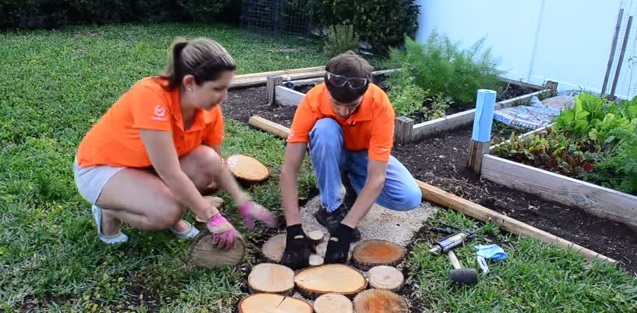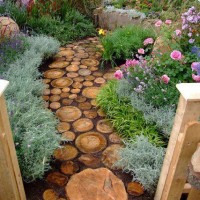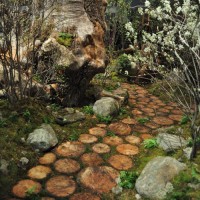Everyone who is lucky enough to have a yard or garden as part of their property can do all kind of things to improve the overall look. The internet is abundant with DIY projects, but none as simple and as effective (in terms of aesthetics) as the one featured here. The natural outdoor pathway made from logs looks so good you’ll be the envy of your entire neighborhood. Learn from DIY experts Katie and Jon Jasiewicz what are the exact steps involved in achieving that result. In the tutorial that they will deliver, you will find out everything from cutting the logs into 2-inch chunks with the chainsaw to arranging all of the stepping `stones` in a nice pathway design. The step by step video walkthrough will be of great assistance. Remember to wear protective gear as well as long sleeves and pants so you won’t harm any of your skin. Good luck!
http://youtu.be/DNw4JD81ngc
- Wood Slices
- Natural Outdoor Pathway
- Using Wood in the Garden






















What would you use instead of Roundup?
Here in Ontario Roundup is a banned substance.
Use a sprayer: 1 gallon distilled vinegar, 2 cups Epsom salts, 1/2 cup dawn dishwashing soap. Spray the weeds in the morning, then later in the day you will see them turning brown. In another 1-2 days the weed is disintegrated (nearly gone).
Cheap and environmentally safe.
Plus, once you are done playing in the yard – fill a hot bath with 2 cups Epsom salts and a little lavender oil. and soak away for 15 minutes.
What brand of sealer did you use at the end? Jon mentioned using it last, but didn’t show it in the clip. I’d love to do this, but do not want to have rotten wood after spending so much time & effort. 🙂 Thanks!
any answer on the rot question????
Stop using Roundup it is cancer causing.
Vinegar and water works just as well as round up. Just mix and spray.
Bake the wood.
You are wasting your time with Roundup. It needs to be sprayed on leaves of plants to do anything. It quickly degrades in the environment. It will not prevent weeds from growing in the future.
I 2nd comments above about using these poisons in the garden and incorrect use on bare dirt. But also concerned at the way in which you are using them without proper protection. Here are handling instructions direct from Monsanto’s website:
“Always read and follow pesticide label instructions. It is against the law to use a herbicide in any manner not specifically listed on the label or contrary to label instructions and requirements.
• Wear protective eyewear, including goggles, shields or safety glasses as required by the product label.
• Wear gloves made of rubber or another material that will prevent contact between your skin and the herbicide solution.
• In most cases, wear your sleeves over the outside of your gloves. Shirtsleeves should only be tucked inside gloves when your arms are raised during spraying.
• Wear a long-sleeved shirt and long pants to protect your skin. On hot summer days, lightweight material or lightweight coveralls are preferable.
• Wear protective clothing until spraying is complete and herbicides are put away.
… But I did come to the page because I like the idea of wood and steppingstones.
Here in Oregon the wood would not last and up to the weather even treated. So trace of wood might matter… Denser the better, and as it degrades it would hold water kind of like a bark mulch path which is fine too
(That should say “cut end upwards, in the weather, even if treated”)
dip the cut wood in borax and water for 15-30 seconds, then let sit for 24 hours, this will keep insects from eating the wood. (trick from cob house building).